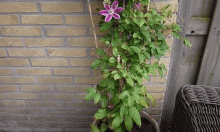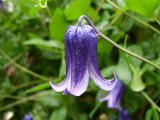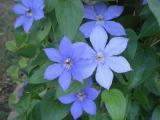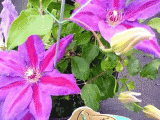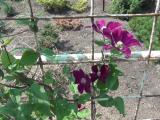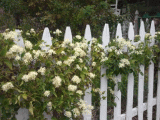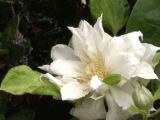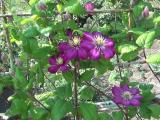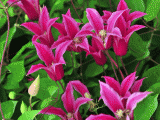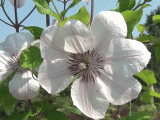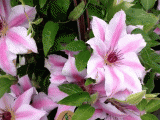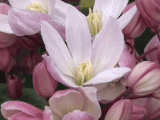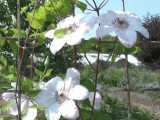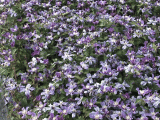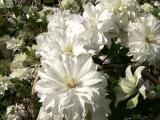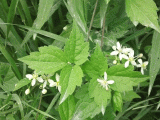Clematis “Rooguchi” comes from Japan and is a hybrid of a c. integrifolia. Its flowers are 2-3" in diameter which is considered to be a small-flowered variety. This species with...
-
Images of Clematis plant and pictures
Click here to see all articles about Clematis
How to Care for Evergreen Clematis Plant
Recently a new fashion trend as vertical gardening has emerged in landscape designing. It has shown to be a very practical and efficient mean of area decoration. Its use allows hiding the unsightly buildings and creating gorgeous green corners. However, not all of the plants are suitable for this purpose; they need to have special features. Clematis is perfect for creating fascinating green landscapes and can be grown outdoors or indoors.
Its maintenance in general includes watering, fertilizing, nothing special. Therefore, any florist can afford caring for clematis. Nevertheless, the process of planting is associated with some difficulties.Clematis from the buttercup family includes up to 300 species of plants with different shapes, colors and sizes of flowers, which is why it is such an appeal to gardeners.
Today clematis is one of the most popular plants used for vertical landscaping and has many wonderful varieties and forms as a result of plant breeding.
Clematis is a herbaceous perennial vine that has flexible steams and shoots that rise to a height of 3 meters, large(flower diameter 5-15 cm) or small(2-5cm in diameter). It blooms profusely and for a long time(up to 3 months) and with good care up to 500 white, yellow, pink, strawberry, cherry-red, blue, violet flowers can simultaneously bloom on one bush. All this causes its widespread use in decorative planting. The most impressively look amazing compositions with all sorts of clematis flower color combinations.
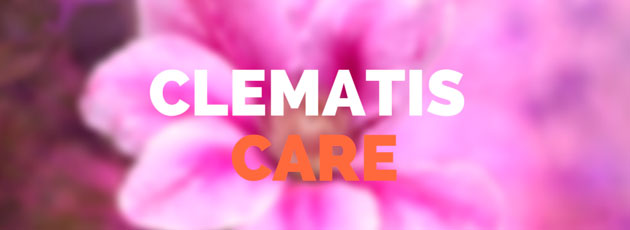
Start Off by Planting Your Clematis. Care Instructions for Dummies
Clematis prefers fertile sandy loamy soil rich with humus, from alkaline to slightly acidic reaction. Since clematis grow in one place for more than 20 years, the soil must be arduously prepared in advance. Usually you need to dig holes not less than 60x60x60 cm, for a group planting the entire planting area must be prepared. The upper layer of the earth should be excavated from the pit and purified from the roots of perennial weeds.
Then the soil is mixed with 2-3 buckets of humus and compost, 1 bucket of peat and sand, 100-150 g of superphosphate, 200 g of mineral fertilizer, preferably 100g of lime or chalk, 200 g of ashes.More peat, humus, clay is added into the light soils. If the area’s soil is moist, dense or loamy, a 10-15 cm layer of gravel, broken bricks or coarse sand is poured at the bottom of the pit. Thoroughly mixed soil is poured into the pit and then sealed.
This process is best to be carried out during autumn in southern areas and in spring or early autumn in areas that are situated further to the north.You have to install a proper and rigid support in the center of the pit. A stretched rope will not do any
good, as it will not be able to protect the young vines from wind gusts. After having filled half of the pit with soil, you need to make a hill from which the roots of clematis will be straightening down to the sides and the bottom.
Hold the plant with one hand and the mixture close to the roots, making sure that your plant is deeply planted. New buds, shoots and roots will subsequently form after the development of the tillering center. These bushes better tolerate harsh winters and suffer less from the heat.
If you plant clematis at the same level with the surface they will be ephemeral, their root system consists out of 1-2 stems and suffers from waterlogging.The bigger the seed is the deeper it should be planted: 8-12 cm deep for young biennial plants, 12-18 cm – for big adult or divided plants. If you are going to plant clematis in spring the planting hole should not be filled with soil to the brim, you must leave 5-8 cm unfilled. After having planted clematis, you need to abundantly water it, shade it from the sun and mulch the soil around the plant with peat.
When planting clematis in autumn the planting hole is filled to the brim and the aboveground part is cut to the ground level or slightly higher.
Requirements for the Planting Material
During the autumn planting clematis should have developed vegetative buds and at least one shoot in the spring. The seeds should have at least 3 roots (10 cm in length). It is important to use only healthy planting material: roots of the seeds should be elastic, without any visible damage, blisters or nodules.
Clematis Care and Growing Conditions
During spring clematis plants are fertilized a lime mixture (200 g of lime per 10 liter of water per square meter). When the weather is dry, plants should be watered abundantly but not often; make sure that the water jet does not reach the central part of the bush.
Clematis should be fertilized at least four times per season with mineral fertilizer with micronutrients (20-40 g per 10 liters or diluted with fermenter mullein), mineral and organic fertilization are alternated.
Since clematis can suffer from overheat and dryness, in the spring the soil must be loosened and then mulched with peat or humus (in northern regions) or sawdust(in southern regions). In spring the vines should be tied and directed in the right direction. Otherwise, the shoots are going to intertwine so much that you will not be able to unravel them.
Before sheltering the plants for the winter season in autumn, carefully prune the bushes and remove the old leaves. During the first two-three years in fall or early spring the bushes are fertilized with rotted manure mixed with any king of potash or phosphate fertilizer as well as wood ashes (a handful for each bucket of compost). Clematis should be fertilized with liquid fertilizer every 10-15 days in small doses.
Are you pondering on the question of when to transplant clematis? The best time to transplant an existing clematis is while the plant is dormant before the new season’s growth begins.
Pests and Diseases of Clematis
Clematis most often suffer from fungal diseases as wilting. Plant’s tissues lose elasticity, then wither and dry out. There are a couple of pathogens of such problems, they live in the soil and affect primarily the root system of the plant.
Therefore, it is very important to follow the agro-technical requirements, especially since the disease can manifest itself even in the early spring. In May you should remove the infected area and water the plant with a two percent solution of Bayleton. Severely affected plants need to be removed along with a lump of soil and the place where they were growing must be disinfected. Bayleton also fights against such diseases as gray mold and mildew.
Curling of the leaves might also turn out to be a virus. Clematis is also affected rust fungal disease which manifests itself as orange pads on the leaves and the shoots in spring.Maintenance and Cutting of the Clematis Vines. How to Prune Clematis?
The beauty of clematis largely depends on how well the trimming was done. When planting you need to shorten the shoots, it is important for the formation of the aerial part of the plant and the root system’s development.
A regulating pruning is carried out during the summer. In order to prolong the blooming period, a part of the shoots is cut in spring. In early summer the vines can be shortened again to the first vegetative buds from which the new shoots and buds are going to grow.Different Species of Evergreen Clematis
Blooming of different types of clematis occurs in different years, so it is important to know when to trim the vines.
Clematis Jackmanii
Rapid growth, long and abundant blooming, a variety of colors and large flower sizes make clematis jackmanii on of the most popular among the other clematis species. It is a woody vine that reaches 3-4 meters in height with imparipinnate leaves. Its flowers reach 10-14 cm in diameter and have four or sometimes six broad sepals.
The flower color is most likely to be violet-purple or pinkish. Blooming is usually very long, from June up to mid-September. The achenes that form the inflorescence have a whitish color, that is why their fruits in the sun acquire a beautiful silver color. Their maturation occurs at the end of September or at the beginning of October. Clematis jackmanii is winter-hardy but a preventive shelter is desirable.Сlematis Armandii
Сlematis armandii is a shrubby vine up to 4-5 meters in height. The leaves are often simple with an oblong-ovate shape, large, leathery, glossy and have a dark green or green color. Сlematis armandii profusely blooms in the southern areas in April and May on the overwintered shoots. It can reproduce by seeds, green cuttings and grafting.
Heavily overgrown shoots should be shortened. It is better to plant it in a protected place. Сlematis armandii grows well on the coast of the Black Sea and Caucasus. It is recommended for vertical gardening in the subtropics, as well as for winter gardens and as a wildcard culture.
How to Propagate Sweet Autumn Clematis Vine
Clematis sweet autumn vine images appeal can lead even the most starveling gardener to attempt its cultivation. Who wouldn’t be seduced by the pictures of a climbing vine that gives off ineffable charm?
How to Grow Clematis from Seeds
Unfortunately clematis can be very expensive to purchase for many gardeners; in order to propagate clematis from a seed you need to learn as much as you can about the germination process
Clematis Ramona is an impressive semi-woody plant that can twine 10’ to 12’ skyward. This vine is a large flowered variety. Its blossoms are 6"-8" in diameter and are of a very...
Clematis is a medicinal herb which has been evaluated for its wonderful healing properties by many people(e.g. over 70 species have been...
Clematis ernest markham is one of the easiest to grow species. It is a spectacular, vigorous, late-flowering vine which can be distinguished by abundant large flowers (4"-6" in...
Clematis is considered to be a plant which can is prone to numerous pests and diseases. If your cultivar is growing fast and is in full flower or near it and you have noticed...
Gourmets and those who love flowers of saturated, vibrant colour and persistent smell will be glad to have clematis wildfire (which in Polish sounds like powojnik wildflower) in...
One day your plant is thriving: it is growing vigorously and you feast your eyes on it. But overnight everything changes dramatically: the vine collapses, withering rapidly. First...
The species which blooms with numerous white star-shaped fragrant flowers from the middle of September through the beginning of October is known under a romantic name – clematis...
If you are not new to the species in question, then you have certainly heard people call clematis queen of all flowering vines. And it’s not just a coincidence that the species got...
If you hear people talking about “queen vines”, undoubtedly the matter is clematis. This plant can be divided into three groups: the species that flowers early, the vine that...
If you hear people talking about “queen vines”, undoubtedly the matter is clematis. This plant can be divided into three groups: the species that flowers early, the vine that...
Invasive plants are considered to be a threat to the native ecosystem. They grow aggressively and it’s extremely hard to control them. Such plants occupy the space of native...
Clematis nelly moser is a hybrid cultivar of clematis languinosa. It is a flowering vine with large flattish pale mauve pink flowers from 6 to 8 inches in diameter. There are...
Clematis snowdrift is also called armandii snowdrift. This evergreen plant is breathtaking. With its gorgeous 4-petaled white scented blooms, it will be a superb choice to...
Clematis flowers are rather fruitful. When in bloom, they create dramatic, spectacular sight. This species is easy to cultivate and maintain, and it is very popular with gardeners...
Plants get sick because of fungus, various clematis diseases and pests. Clematis wilt (sometimes it can be called clematis leaf and stem...
Clematis have an undeserved reputation for being hard to grow. The species will thrive if the vines get plenty of sunlight whereas the roots are shaded. Some specimens have single...
Clematis virginiana is also known as Woodbine Devil's Hair, Devil's Darning Needles, Traveller's Joy, Virgin's Bower, Virginia Virgin's Bower, Love Vine and Wild Hops. This...






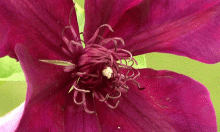 ,
, 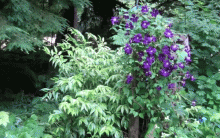 ,
, 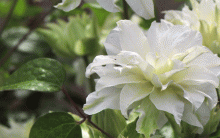 ,
, 